| 浙江大学之江校区 | |
 The Economics Building in 2018 The Economics Building in 2018 | |
| Former name | Hangchow Christian College Hangchow College Hangchow University |
|---|---|
| Established | February 1911; 113 years ago (1911-02) |
| Parent institution | Zhejiang University |
| Address | 51 Zhijiang Road, Hangzhou, Zhejiang, 310008, China 30°11′42″N 120°07′14″E / 30.19513°N 120.12043°E / 30.19513; 120.12043 |
| Campus | 43.33 hectares (107.1 acres) |
| Former Site of Hangchow University | |
|---|---|
| Chinese: 之江大学旧址 | |
 | |
| Major Historical and Cultural Site Protected at the National Level | |
| Location | Hangzhou, Zhejiang, China |
| Coordination | 30°11′42″N 120°07′14″E / 30.19513°N 120.12043°E / 30.19513; 120.12043 |
| Historical era | Republican era |
| Batch number | 6-951 |
| Registered | May 25, 2006; 18 years ago (2006-05-25) |
Zhijiang Campus is an urban campus of Zhejiang University located in Hangzhou, Zhejiang, China. Located on riverside of the Qiantang River and close to the Liuhe Pagoda, it was the oldest university campus in Hangzhou. Built as the campus of Hangchow University, one of the oldest Christian colleges and universities in China, most of its buildings are protected as the Hangchow University Historic Site under the list of Major Sites Protected at the National Level. The campus is now home to James D. Watson Institute of Genome Sciences, Guanghua Law School and the Institute for Advanced Study in Humanities and Social Sciences.
History
Main article: Hangchow UniversityThe planning of the campus began in 1906, in which year, four foreign missionaries of Presbyterian Church in the United States of America, each based in Hangzhou, Ningbo, Shanghai and Suzhou, along with a representative of the faculty of Hangchow Presbyterian College formed a board of directors. The first meeting of the board was held in November, during which the board resolved to build a new campus outside the urban area of Hangzhou. After the meeting, the college slowly purchased the land of the campus, until the construction began in 1909. As a member of the board and a representative of the churn in Hangzhou, John Leighton Stuart was a major participator during planning and construction, along with his family in Hangzhou. His brother Warren Horton Stuart taught at the college and served as the president of the college from 1916 to 1922, who lived in the Paxton Residence on the campus with his family.
The construction was finished in two phases. With Phase 1 most finished in the Winter of 1910, Hangchow Presbyterian College moved into the campus from Dataer Lane in the city centre of Hangzhou in February 1911. The Chinese name of the college was changed from Yuying (育英, literally nurturing the elites) to Zhijiang (之江, literally "the river", referring to the Qiantang River that the campus borders) after the relocation. In 1914, the college was renamed as Hangchow Christian College in English. In Chinese, it was renamed as Zhijiang University (之江大学).
After the relocation, new buildings continued to be built in the campus. In 1913, the Philadelphia Observatory was built. A wooden bridge was built over the stream in the campus in 1916. In 1918, the Tooker Memorial Chapel was built, along with the systems of tap water and electricity. As the Sino-Japanese war hit Hangzhou in 1937, the Philadelphia Observatory was destroyed by Japanese bombing and the university moved away from Hangzhou to evade the war. During the wartime period, the campus was in poor maintenance. When the university returned to the campus after the war, a major renovation began in March 1946.
In 1951, the university ceased to operate under the new Communist rule, with the American faculty moving to Hong Kong to found Chung Chi College and the campus taken over by the Department of Culture and Education of Zhejiang Provincial Government. During the 1952 reorganisation of Chinese higher education systems, the university was cancelled, with the campus taken over by Zhejiang Teachers College. In 1958, with the merger of Zhejiang Teachers College and Hangzhou University, the campus was reassigned to the Party School of the Zhejiang Provincial Committee of Chinese Communist Party. In 1961, the campus was gained by Zhejiang University. The campus was once renamed as Zhijiang College of Zhejiang University in 1996, but was later renamed as Zhijiang Campus.
In 2002, Zeng Xianzi Teaching Building was built with the 4 million Hong Kong dollar donation from Hong Kong businessman Tsang Hin-chi. In 2006, the old buildings built by Hangchow University was listed as a Major Historical and Cultural Site Protected at the National Level by the State Council, with the name Former Site of Hangchow University. In 2007, a major renovation of the campus began.
Architectural designs
The campus was built in Mount Qingwang upon the Qiantang River, with a total area of 650 mu and a total building area of 70,000 m. Characterised by redbrick buildings, the campus is considered one of the most beautiful university campuses in China. The campus is American styled, with campus buildings adopting both traditional Chinese and western architectural styles and a central garden where Sun Yat-sen made a public speech on 10 December 1912 during his visit to the university. Severance Hall used to have a Chinese-styled rooftop, which was replaced a hip roof in the 1946 renovation. The Paxton Residence and the North Pacific Residence are major residences in the campus, which are characterised by classical architectural features, including round arches, red brick exteriors and an arcade. The Tooker Memorial Chapel, a grey neo-Gothic building, was the only religious building in the campus. Zeng Xianzi Teaching Building, designed by the Architectural Design & Research Institute Of Zhejiang University (UAD), used similar red bricks as a major building materials, to mimic the styles of the historical buildings in the campus.
| Original English name | Chinese names | Photo | Year of establishment | Notes |
|---|---|---|---|---|
| Severance Hall | 主楼
(慎思堂) |

|
1911 | |
| Economics Building | 经济学馆
(同怀堂、邓祖询纪念馆) |

|
1936 | Donated by Sze Yun-ken, a Hangchow alumni and the son of Sze Liang-tsai, a major Chinese journalist murdered by Chiang Kai-shek's henchmen. In Chinese, the building is also known as Deng Zuxun Memorial Hall. Deng Zuxun was a Hangchow student murdered in the same car when Sze Liang-tsai was murdered. |
| Alumni Library | 图书馆 | 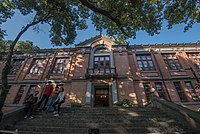
|
1932 | Now Guanghua Law School Library |
| Gamble Hall | 1号楼
(东斋、甘卜堂) |

|
1911 | Donated by the David B. Gamble family from Cincinnati, Ohio. |
| Wheeler and Dusenbury Hall | 2号楼
(西斋、惠德堂、吴窦堂) |
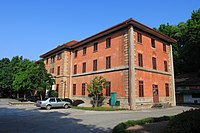
|
1911 | Formerly, boys' residential hall |
| Tooker Memorial Chapel | 小礼堂
(育英堂、都克堂) |

|
1919 | Donated by the Nathaniel Tooker family from East Orange, New Jersey, United States. Designed by J. W. Wilson. |
| Converse Residence | 灰房
(康沃斯楼) |

|
1911 | Formerly, foreign professors' residence |
| North Pacific Residence | 上红房
(北太平洋楼) |

|
1911 | Formerly, residence of the president |
| Paxton Residence | 下红房
(帕斯顿楼) |
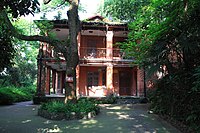
|
1911 | Formerly, foreign professors' residence |
| Judson Science Hall | 4号楼
(裘德生科学馆) |

|
1932 | Named after Rev. J. H. Judson, the president of Hangchow Presbyterian College |
| Wilson Hall | 6号楼
(佩韦斋、韦斋) |
1926 | Formerly, foreign professors' and girls' residence | |
| Wheeler Residence | 9号楼
(维勒邦格楼、绿房) |
1920 | Formerly, foreign professors' and girls' residence | |
| Materials Testing Laboratory | 5号楼
(材料试验所) |
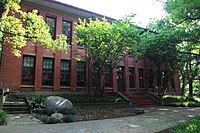
|
1935 | Now part of Guanghua Law School Library |
| Carter Memorial Residence | 白房 | 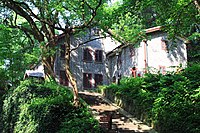
|
1920 | |
| Engineering Hall | 工程馆 | 
|
1951 | |
| Residence of Affiliated Primary School | 附属小学宿舍 | 1931 | Now residence of faculty | |
| Gym Office | 体育办公室 | 1934 | ||
| Student Service Center | 学生服务部 | |||
| 后六号楼 | ||||
| Chinese Professors' Homes | 中方教授宿舍 | 1915 | Formerly, homes to three Chinese professors | |
| Philadelphia Observatory | 费城观象台 | 1913 | Donated by Mrs. Charles P. Turner. Destructed in 1937 due to Japanese bombing. |
Institutions
- Faculty of Social Sciences:
- Institute for Advanced Study in Humanities and Social Sciences
In popular culture
- The 2010 movie Aftershock was shot on location within the campus to mimic a Chinese university life in the 1980s. Hangzhou Medical School, where the heroine of the movie, played by Zhang Jingchu, studies, was filmed on the campus, which made the Economics Building of the campus a popular tourist attraction.
- The 2015 movie The Left Ear was filmed on the campus.
- Janet Fitch wrote an autobiography which describes her life in the campus from 1909 to 1935.
See also
References
- 之江校区 Archived February 6, 2005, at the Wayback Machine
- ^ "杭州最古老的大学校区 红房子里藏着"时光机"". 凤凰网. 2014-09-28. Archived from the original on 2022-05-30. Retrieved 2022-05-29.
- "浙大之江校区钟楼重新开放 这里可以眺望钱塘江江景". Qianjiang Evening News. 2016-12-21 – via Tencent News.
- ^ "杭州之江大学旧址". 浙江文物网. 2016-09-10. Archived from the original on 2021-06-13. Retrieved 2021-04-17.
- ^ "浙江大学丨百年老楼、历史回眸(四)". z.hangzhou.com.cn. 2020-05-14. Archived from the original on 2022-05-30. Retrieved 2022-05-29.
- "曾宪梓教学楼在之江校区落成". Zhejiang University. 2002-04-04. Archived from the original on 2022-05-30. Retrieved 2022-05-29.
- "曾宪梓教学楼". Zhejiang University Education Foundation. 2015-02-03. Archived from the original on 2022-05-30. Retrieved 2022-05-29.
- "国家文物局2006年发布的第六批全国重点文物保护单位名录". Archived from the original on 2014-10-06. Retrieved 2014-10-05.
- ^ "浙江大学之江校区:大学的建筑与人文之美_培训动态_浙江大学". Zhejiang University. Archived from the original on 2022-05-30. Retrieved 2022-05-29.
- Zhang, Ji (2008). 之江大学旧址建筑年谱 (Master's thesis) (in Chinese). Hangzhou: Zhejiang University.
- Zhang, Ji (2009). 之江大学旧址建筑史初探 [A preliminary study on the architectural history of Hangchow University] (in Chinese). Hangzhou: Zhejiang University Press. ISBN 978-7-308-06564-1. OCLC 461868555.
- "之江大学旧址". 杭州政协. 2010-10-26. Archived from the original on 2021-04-16. Retrieved 2021-04-17.
- "浙大之江校区钟楼重新开放 这里可以眺望钱塘江江景". Qianjiang Evening News. 2016-12-21 – via Tencent News.
- "钱塘江边这些大学,都是满满的校园回忆……". Hangzhou Net. 2018-09-12. Archived from the original on 2022-05-30. Retrieved 2022-05-30.
- Fitch, Janet (1981). Foreign devil: reminiscences of a China missionary daughter 1909-1935. San Francisco: Chinese Materials Center. ISBN 978-0-89644-647-2. OCLC 10323308. Archived from the original on 2022-05-30. Retrieved 2022-05-29.
| Zhejiang University | |||||||||||||||||||
|---|---|---|---|---|---|---|---|---|---|---|---|---|---|---|---|---|---|---|---|
| |||||||||||||||||||
| |||||||||||||||||||
| |||||||||||||||||||